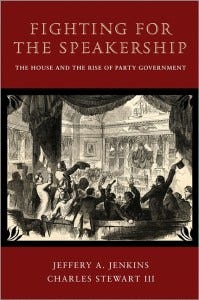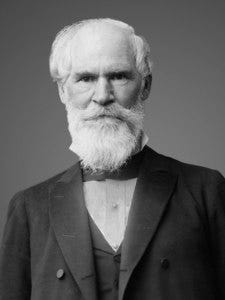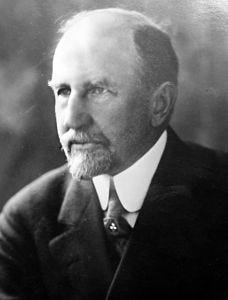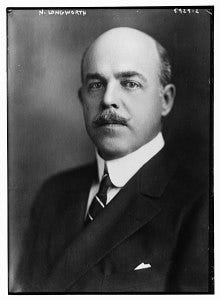Back to the Future? Battling Over the Speakership on the House Floor
By Jeffery A. Jenkins and Charles Stewart III
The House of Representatives votes to elect its Speaker today—or, at least, that’s the plan. The problem is that the ostensible favorite, Rep. Kevin McCarthy (R-CA), has yet to line up a majority of the House to win the position. Five conservative Republicans have announced their opposition to his candidacy, and they’ve held firm despite his entreaties.
Without a majority, there is no Speaker. Without a Speaker, the House cannot conduct business, except to keep voting for Speaker until someone gets a majority.
The last time the House failed to elect its Speaker on the first ballot was in 1923, when a small group of Republican progressives chafed at the firm hand of the Republican establishment and forced nine ballots before a Speaker was chosen.
We explored the ins and outs of speakership contests in our 2013 book, Fighting for the Speakership: The House and the Rise of Party Government. That book was inspired by fights over House leadership that could consume days, weeks, and even months. We think that it is natural to consider what history has to say about the predicament in which McCarthy and the House find themselves.

When we set out to write Fighting for the Speakership, the contrasts between the current and antebellum periods were striking. In the adult experience of every living American, the election of the Speaker was a heavily stage-managed affair. Few had any memory of 1923 at all, not to mention remembering that it took three days and nine ballots to elect Frederick Gillett (R-MA) Speaker. From 1865 to 2013, the House had elected speakers 32 times, and only once did it have to go to a second ballot.
In contrast, prior to the Civil War, the House voted to elect a Speaker 40 times, taking multiple ballots at least 14 times. Three in particular stand out: the 63 ballots and six weeks to elect a Speaker in 1849, the 133 ballots and two months to elect a Speaker in 1855-56, and the 44 ballots and two months to elect a Speaker in 1859. Since the contest of 1861, on the eve of the Civil War, 1923 is the only time when the House has deadlocked over electing a Speaker.
Not surprisingly, most of these protracted contests were over slavery and other regional issues—especially after 1839, when the House stopped using the secret ballot to elect Speaker and adopted the current practice of taking a viva voce roll call. The primary reason these contests reached an impasse was the impossibility of creating inter-party coalitions to organize the House. Northern members, who comprised a majority of the chamber, refused to reach across the aisle to elect a Speaker. Slavery was a dividing line, but party was an even stronger divider.
This all stopped on July 4, 1861. Because of secession, Republicans held a comfortable House majority. However, even in the midst of the greatest crisis this nation has faced, they could not settle on a Speaker nominee ahead of the convening. When the ballot for Speaker was taken, Radical Republican Galusha Grow (PA) had received 71 of the 159 votes cast, nine short of a majority. However, before the results could be announced by the clerk, the second-place finisher, Frank Blair, a moderate Republican from Missouri, and a lapsed Democrat, took the floor, withdrew from the contest, and urged his supporters to change their vote in favor of Grow. Which they did. Grow was officially elected on a single ballot.
From then on, majority parties settled their fights over the speakership in caucus, presenting a united front when the House organized. The losing majority-party factions would then be compensated with prime committee assignments. Republicans began this tradition when the House reconvened in 1863. Democrats kept with the tradition when they returned to a majority in 1875. This practice evolved into something we call an “organizational cartel,” which was a necessary condition before the majority-party “procedural cartel” (ala Cox and McCubbins 2005) could be developed decades later.
Keeping the fight for the Speaker in the family was easier in some historical moments than others. The 1910s and 1920s were one of those difficult times, especially for the Republican Party which, on the one hand, was the nation’s majority party but, on the other, harbored tensions between conservative stalwarts and progressives. This progressive-conservative infighting famously erupted in the revolt against Speaker Joseph Cannon (R-IL) in 1910, but the damage done was to the power of the Speaker under the House rules, not against the firm hand of the Republican Caucus in keeping control over who would be Speaker.
The 1923 episode was another eruption of these tensions. Then, progressive Republicans demanded rules changes to share power more equally in the House. (Sound familiar?) The Republican leader, Frederick Gillett refused. The progressives stuck to their guns, and in the first ballot for the speakership, 20 Republicans voted for other candidates, leaving Gillett without a majority. Two days and eight more ballots later, Gillett capitulated. The progressives got their rules changes, and Gillett was elected Speaker with the support of 18 of the progressives.
This was all fine for the insurgents until the next Congress, which was a roaring national victory for traditional Republicanism. The new GOP Speaker, Nicholas Longworth (OH), no longer needing the support of progressive Republicans to hold onto power, punished them for their previous intransigence by stripping them of committee memberships and seniority.
After Longworth meted out very public punishment to the progressives in 1925, there were almost no party defections on the speakership vote for nearly 90 years. However, by 2010, the rise of the Tea Party movement began to bring this organizational cartel arrangement under stress, especially in the Republican Party.
Strains were particularly evident in 2013, when twelve Republicans refused to vote for John Boehner (OH), and in 2015, when 24 House Republicans defected. Boehner preempted a vote later in 2015 to “vacate the chair”—which was pressed by the House Freedom Caucus and other far-right Republicans—by quitting. Internal party divisions complicated selecting a successor. The reluctant eventual choice, Paul Ryan (WI), saw ten of his co-partisans vote against him when he was elected Speaker. Ryan’s tenure as Speaker was also filled with fights between the right and moderate wings of the party. Prior to the November 2016 election, when the smart money was on Hillary Clinton defeating Donald Trump for President, Washington speculation ran wild about the likelihood that Ryan might be deposed as Speaker in the lame-duck session following a Trump defeat.
Strains in the organizational cartel have also been seen among the Democrats, although not as dramatically or persistently. It is now widely forgotten that in 2010, two dozen Democrats ran for reelection pledging to oppose Nancy Pelosi’s reelection as Speaker. The shellacking received by Democrats in that year, leading to the loss of the House, perhaps saved Pelosi from a multi-ballot Speaker election of her own. After the 2018 election, Pelosi secured her reelection as Speaker, in the face of sufficient holdouts on the right of her party to jeopardize a first-ballot victory, with a promise to step down as Democratic leader following the 2022 election.
The history of speakership contests underscores the corner Kevin McCarthy is painted into and, indeed, the corner any Republican House leader is likely to face in the current partisan environment.
On the one hand, it is tempting to believe that McCarthy has a strong bargaining hand against the Freedom Caucus holdouts, because they don’t have what the progressive Republicans had in 1923—a plausible threat to organize the House with the Democrats. However, it is important to remember that many of the members he is trying to woo—and their ideological forebearers—have been willing to shut down the government before, despite a broad consensus that doing so would be bad for the Republican Party.
The most unlikely outcome of the current standoff is an inter-party coalition that joins together Democrats with Problem-Solvers-Caucus Republicans to elect a speaker—retiring Representative Fred Upton (R-MI) has been touted as the candidate to beat in this scenario. Aside from the fact that a cross-party coalition has never been successful in the history of the country—see the summary of our book above—and cross-party coalitions do sometimes occur in state legislatures—the Upton Gambit runs up against the problem of progressive Democrats voting for a Republican as Speaker. Numerically, this presents at least as many problems on the left as McCarthy has on the right.
This leaves us with the most likely outcome: more of the same. Even if the speakership election goes multiple rounds, far-right Republicans cannot achieve their most wished-for goals in the 118th Congress until it organizes. (The Biden Administration has already turned back requests from presumptive Republican committee chairs for documents, arguing that until the House organizes, no oversight can be done.) McCarthy seems to want the speakership badly enough to cede as much power to his caucus as it takes to get elected. (Doing so would still give him greater control over the chamber than Cannon had in 1910 or Gillett in 1923.) However, this outcome just kicks intra-party conflict down the road, threatening a McCarthy speakership in the vein of Boehner’s and Ryan’s.




